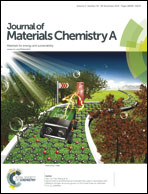Controlled electrochemical growth of Co(OH)2 flakes on 3D multilayered graphene foam for high performance supercapacitors†
Abstract
The present research describes successful enchase of Co(OH)2 microflakes by the potentiodynamic mode of electro-deposition (PED) on porous, light weight, conducting 3D multilayered graphene foam (MGF) and their synergistic effect on improving the supercapacitive performance. Structural and morphological analyses reveal uniform growth of Co(OH)2 microflakes with an average flake width of ∼30 nm on the MGF surface. Moreover, electrochemical capacitive measurements of the Co(OH)2/MGF electrode exhibit a high specific capacitance of ∼1030 F g−1 with ∼37 W h kg−1 energy and ∼18 kW kg−1 power density at 9.09 A g−1 current density. The superior pseudoelectrochemical properties of cobalt hydroxide are synergistically decorated with high surface area offered by a conducting, porous 3D graphene framework, which stimulates the effective utilization of redox characteristics and mutually improves electrochemical capacitive performance with charge transport and storage. This work evokes scalable electrochemical synthesis with the enhanced supercapacitive performance of the Co(OH)2/MGF electrode in energy storage devices.


 Please wait while we load your content...
Please wait while we load your content...